Alternate Positions (And How to Use Them)
- PDF of Music Examples in this Article
- More Pedagogical Resources at Dr. David Mathie's YouTube Channel
In the brass family, alternate fingerings are rarely needed and rarely used, with the exception of the trombone. On our instrument, alternate positions are of vital importance and make it possible for us to have technical facility approaching that of the valved brass. Due to the length and somewhat cumbersome nature of the hand slide, our technique is hampered by the time needed to move the slide from one position to the next. Not only do alternate positions make difficult passages easier by avoiding awkward slide motion, they also help make possible many natural slurs, and special techniques such as glissandos and lip trills.
At first, notes in alternate positions have a thinner, less centered sound than usual, so often trombonists are reluctant to use these except when a passage is impossible to play without them. Because of this, many advanced trombonists have suggested that we avoid thinking of them as "alternate positions" and rather consider them as notes with many "position options," as an advantage rather than a drawback.
Let's look at the various ways that alternate positions can make us better musicians. First, we need to understand why these exist and how to find them.
Alternate positions are made possible by a note appearing in different overtone series. On the Bb trombone, we have seven series: on Bb, A, Ab, G, Gb, F and E. In order to find an alternate for middle F, we look at the two overtone series on Bb and F (see example 1 below).

We see that the middle F is the third partial of the Bb overtone series and the fourth partial of the F overtone series. Therefore, F can be played in both first and sixth positions. As we go higher on the instrument more options are possible. As shown in example 2, high Bb is the eighth partial of the Bb overtone series, the ninth partial of the Ab series, the tenth partial of the Gb series, and (as an A#) the eleventh partial of the E series. So, high Bb can be played in 1st, 3rd, 5th and 7th positions (making the second glissando from high Bb to Db in Bolero possible by playing from 5th to 2nd position, as we will see later in this article).

Because many partials are inherently out of tune, in this article I'll use "#" for a raised (or sharp) position, and "b" for a lowered (or flat) position. Thus, middle D is in b4, middle Bb is in #5. I'll also use "v" for F attachment positions (C is in v1).
Next, we'll look at the different ways alternate positions can help our playing.
Improving Technique By Avoiding Abrupt Changes In Slide Direction
This is the most common use of alternate positions. A good rule of thumb when playing fast passages is to keep the slide moving in the same direction as long as possible. This can be understood by looking at the two passages in the example below.
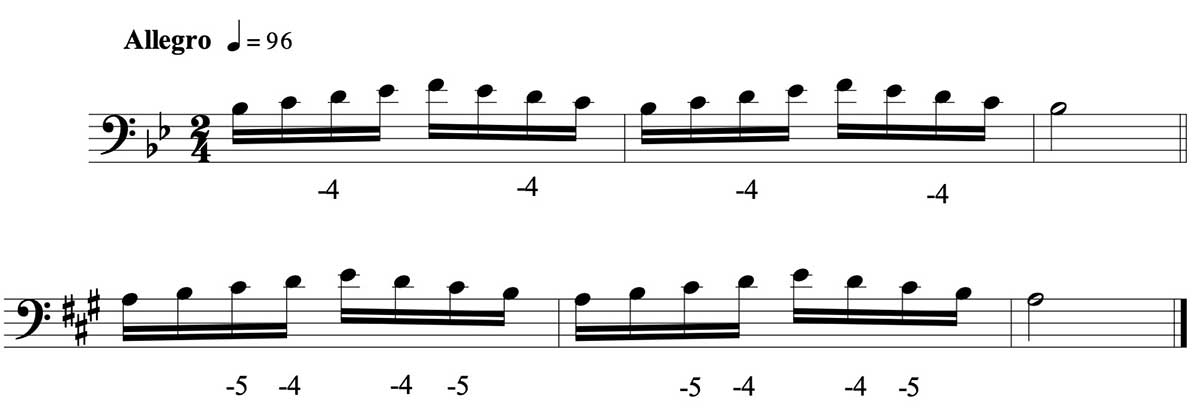
Playing either of these without alternates, at the tempo indicated, would be next to impossible; the slide simply cannot be moved back and forth quickly enough to make it work. By using the alternates indicated the slide does a smooth back-and-forth motion from 1st to -4th and back (or 2nd to -5th and back in the second line) and the passages are playable, even at double-tongue speeds.
As noted before, many trombonists are reluctant to use alternate positions because, at first, the tone quality is thin. However, the tone will improve the more the player uses the alternate and finds the right embouchure/air speed combination to "temper" the tone. I would even go so far as to suggest that in the key of Bb the "normal" position for middle D before or after a 3rd position note should be -4, regardless of tempo! A good real-life example is from the last movement of Vaughan Williams' Folk Song Suite, given below.

In addition to the use of this position for the Ds in the 16th note passages, notice how that position is used in ms. 8, where the trombonist should play the long D in 1st but then switch to -4, moving the slide smoothly from -4 to 1st.
Avoiding Awkward Slide Motions
The example below shows the next use of alternates. The first measure, F to Gb and back, is certainly playable using 1st to 5th positions, but using 6th as an alternate eliminates the frantic slide motion. The same is true with the higher passage in the second line.

An infamous passage from the march literature is in the example below, which the author has seen far too many times being done without the 5th position alternates that are marked.
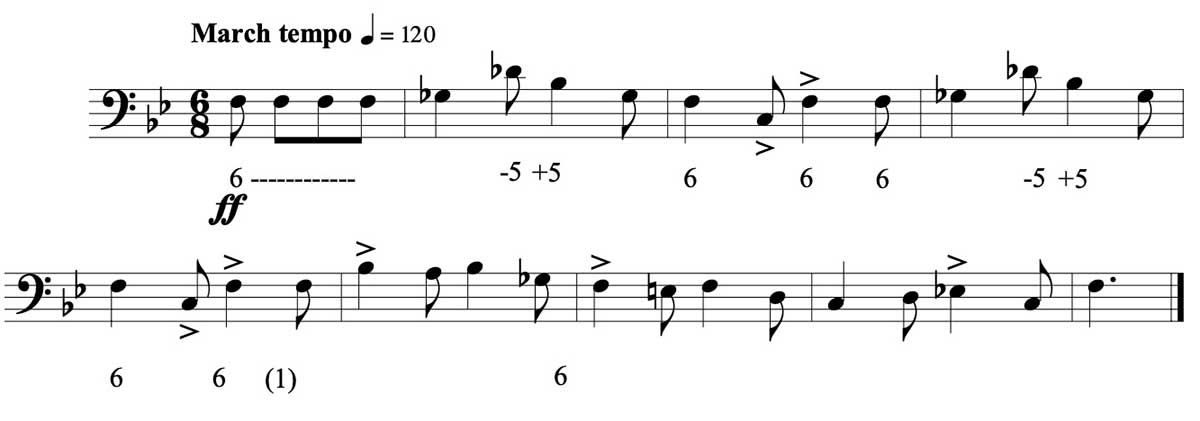
Obviously this passage should be learned slowly: in the second measure the Gb, Bb and Db are all in different 5th positions. Notice that the middle F (last note in the fourth full measure) in 1st seems to contradict what I've written above; however, it allows the subsequent Bb to be done in 1st position, and there is sufficient time after the quarter note F to move the slide up to 1st.
A final passage is from the Bordogni/Rochut etude book, which shows how alternate positions can be used not just to avoid abrupt slide motions but to allow smoother and more secure legato. This can be seen in the example below, where the F in 6th in measure one avoids an awkward 1st to 5th shift while the in measure three the Bb in #5 gives a smoother slur than would be possible using 1st.

Using Alternate Positions For Natural Slurs And Grace Notes
Natural slurs are unique to the trombone and offer a lightness and smoothness to our playing that is not true of legato tonguing or lip slurs. An example of the first, a light style in slurring, can be seen below.
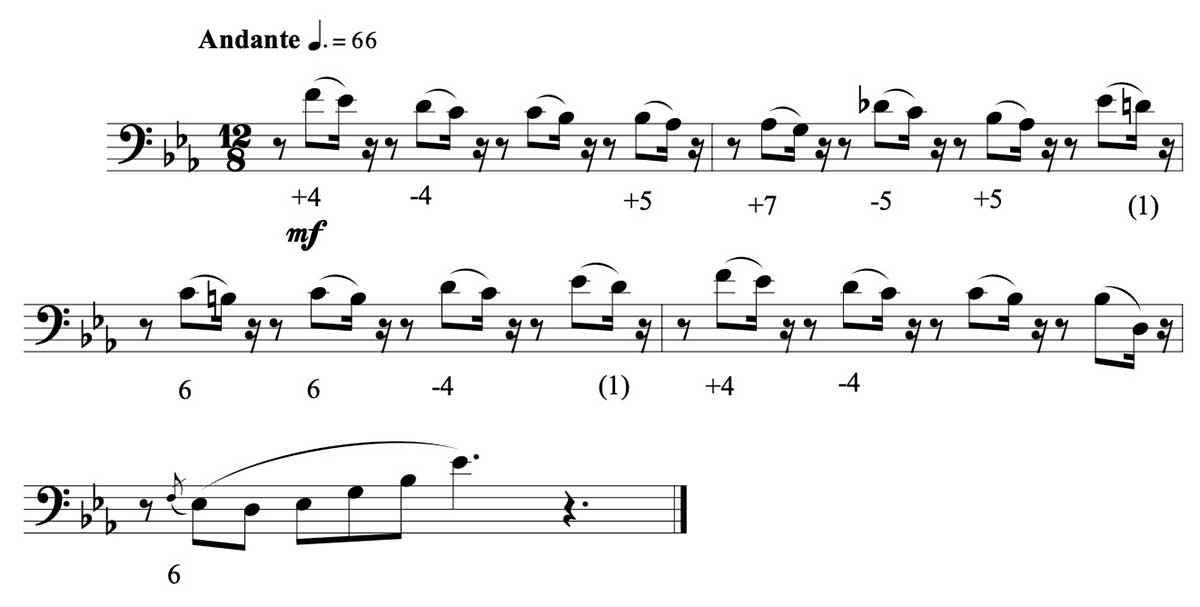
By using these alternates every two-note passage can be done as a natural slur (personally I wouldn't use the middle Ab in 7th or the middle C in 6th, but it can be done). By playing this example with standard positions, then again with the alternates, you can see how the light, flute-like quality of the natural slurs makes this passage work.
A fascinating historical example of a composer specifying natural slurs is the opening passage of Gustav Holst's Hymn of Jesus, where Holst (who was a fine trombonist as well as a composer) specifies the exact positions to be used, and adds a note that suggests his contemporary trombonists may not have been as accomplished as we are today!
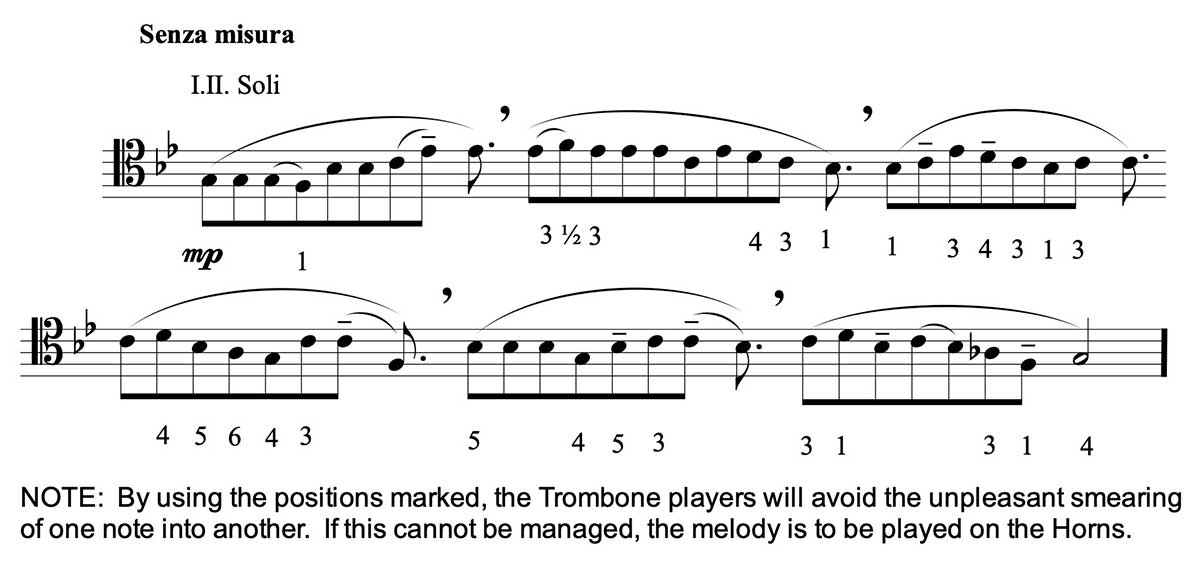
As seen below, alternates may also be used to give grace notes with their characteristic lightness.

Using F-attachment Alternates
Typically the F attachment provides alternate positions for low C and B natural, as well as extending the range below the lowest E. Many trombonists are not aware of one of the most important F attachment alternates: the low Bb in v-3 (significantly lowered third position, usually below the bell). This is extremely helpful for technical passages in the key of Ab, where a rapid passage using the run Ab (3)/Bb (1) /C (v1) /Db (5) requires a fast shift from C in v1 to Db in 5. However, using these positions, Ab (3)/Bb (v-3)/C (6)/Db (5), the awkward shift is eliminated.
The F attachment alternate for Bb may also be used to provide a more secure legato slur in and out of low Bb by making the slide movement shorter. This can be seen below in the famous, and rather low and exposed, first trombone solo from the first movement of Saint-Saëns' Symphony No. 3.

While the trombonist could certainly use "normal" positions in the first four notes, playing the slurred Bb to Db that way can risk the chance of the Db not speaking; playing the Bb with the valve makes the passage much easier.
Glissandos
Trombonists' unique special effect, the glissando, can be fun to play and even more fun for the audience, but sometimes composers write glissandos that can't be played using standard positions. Often using an alternate will fix this. A good example is the solo glissando Stravinsky wrote in his second version of the Firebird Suite, seen below.

Stravinsky, ever the perfectionist, even supplied his own positions for this glissando. He also notated the base rhythm to indicate to the player the speed of the glissando. Ravel, in Bolero, indicated the glissandos by using a line between the first and last note. As in the Firebird Suite, the glissandos can only be done using alternates: G in 4th to Bb in first, then Bb in 5th to Db in 2nd.
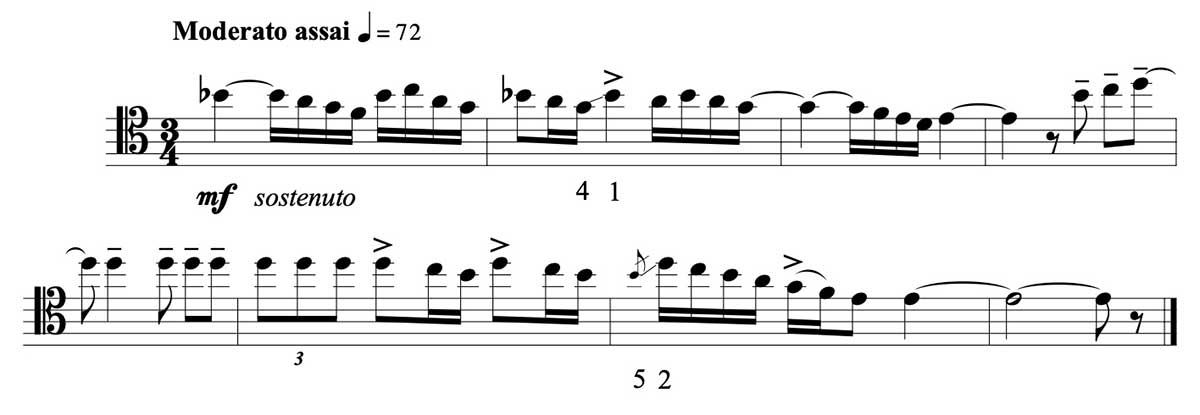
Lip Trills
The final use of alternates is to make certain lip trills possible and also more easily played. These trills are available to trombonists because from the seventh partial and higher the notes are spaced a whole step apart; the player just needs to be aware of the intonation problems with the seventh partial. For example, a trill from high G in #2 to A in 2 is possible, but without adjusting the slide one of the two notes would be unacceptably out of tune. Playing both notes in 4th position fixes this, as we see below in the trill at the ending of Stravinsky's Firebird Suite.

Similar trills can be played in tune by using alternates: high F# in #3 to G# in 3 can be played in tune by using 5th position, high F in 1st to G in #2 can be done in 4th position, etc.
Another advantage to using these alternates for trills is that to the player these notes feel less "solid" than the normal position, and thus easier to slur back and forth. This can be seen by playing a lip trill between high Bb and C in 1st position, then trying it in 3rd, or a trill between high A and B in 2nd, then trying the same trill in 4th.
Practicing Alternates
One method I have used in my teaching career is to have a student take an etude, mark in every possible alternate position, then play it that way every day for a week. The example below shows this.
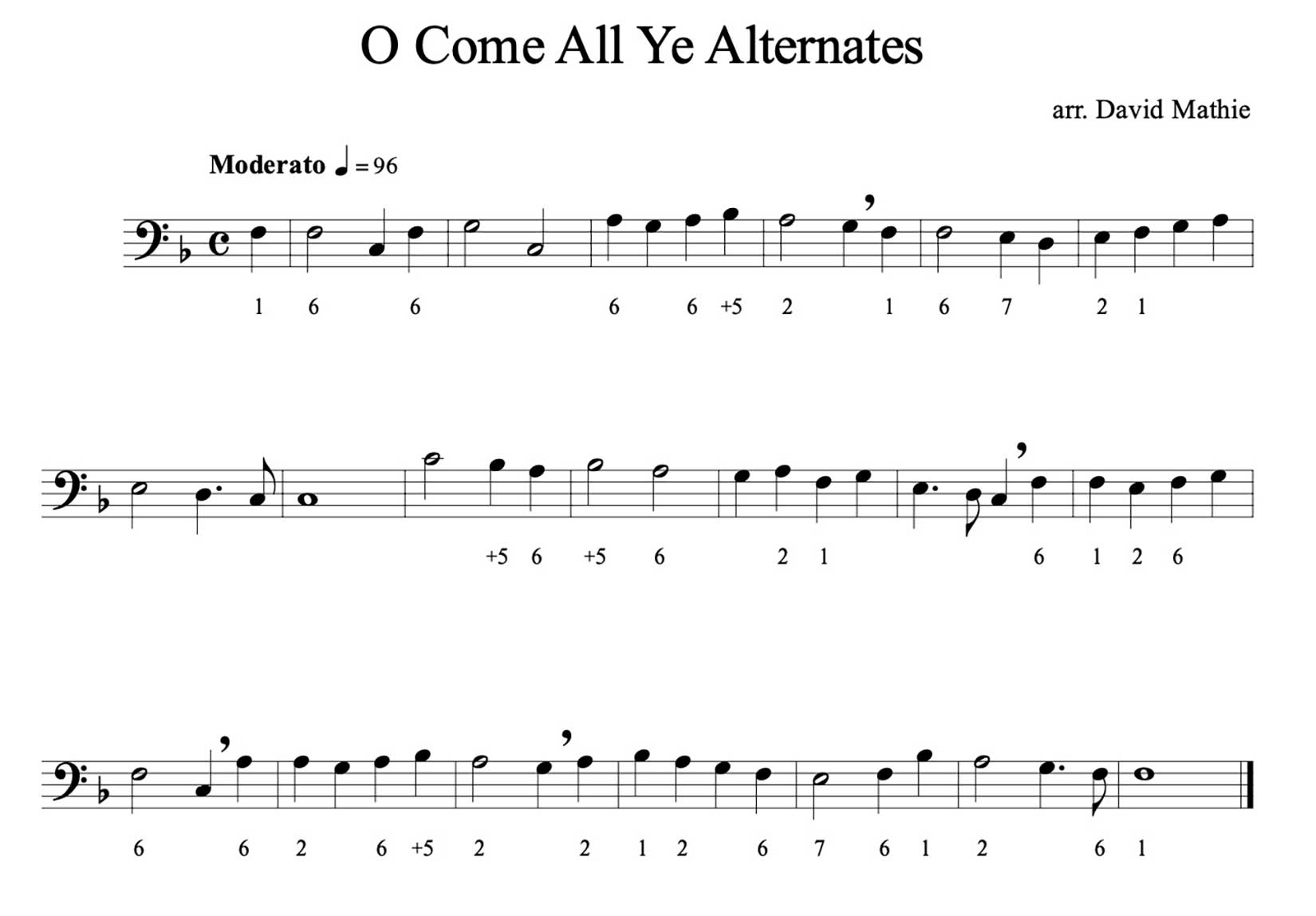
For the advanced player, these two etude books offered more challenging alternate work:
- Robert Marsteller, Advanced Slide Technique (Southern Music)
- David Uber, Intonation Studies for Trombone (Robert King Music)
Summary
To sum up, alternates on trombone make technical passages easier to play by keeping the slide moving in the same direction as long as possible to avoid awkward and abrupt changes in slide directions. But the trombonist should also be aware that they help us in legato playing, in playing ornaments and in making certain glissandos possible. Think of alternates as different options in slide placement, depending on tonality and slide motion, and realize that the more we use them the more they cease to be a problem and become a solution.
